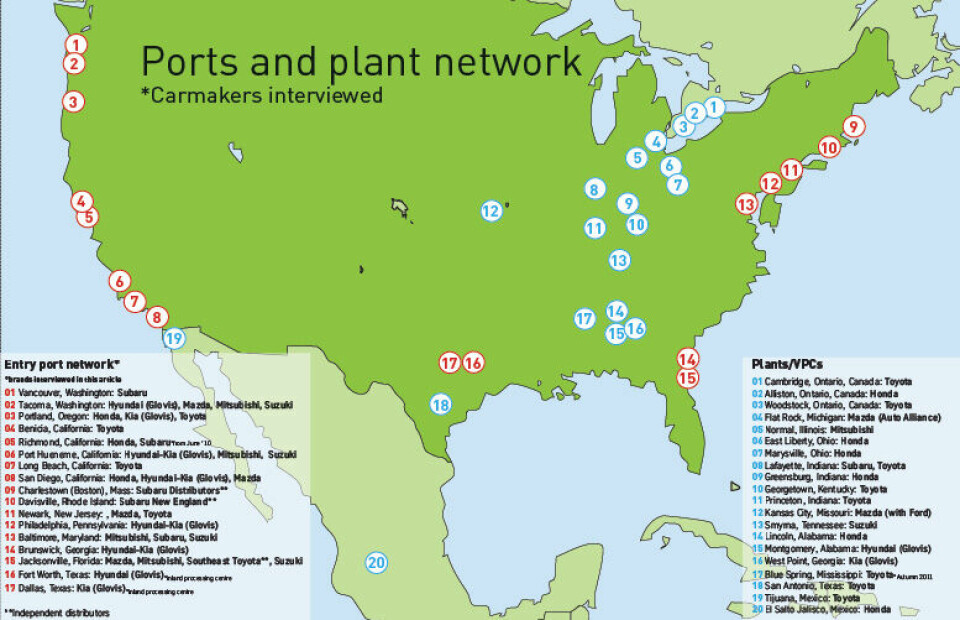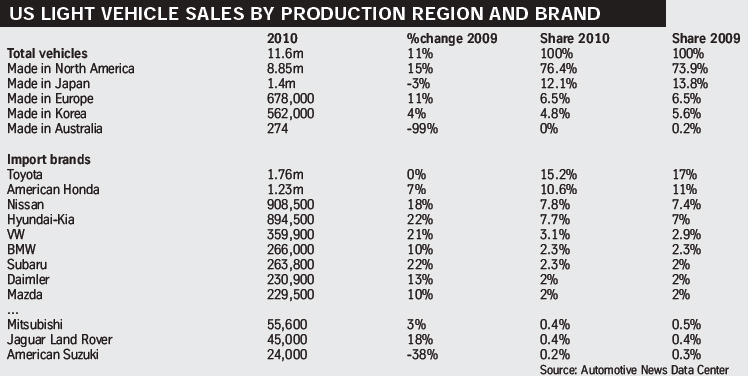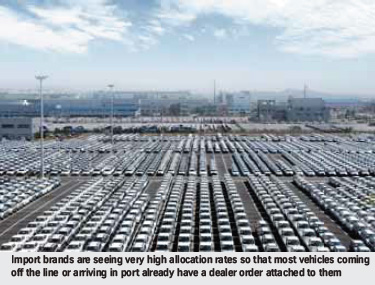Growing deeper roots

Transplant brands in the US are facing pressure from currency fluctuations and resurgent domestic OEMs, putting more pressure on the bottom line, including maintaining lower inventories and meeting stricter delivery times, writes Christopher Ludwig.
The strength of import brands has long been an important characteristic of the US car market, both in terms of vehicles imported and those built in transplant factories opened on North American soil. While volume has decreased with the downturn, the proportion of light vehicles sold in the US imported from outside the Nafta region has held reasonably steady around 25% in recent years; in 2010 it was 23.6%, higher in volume from 2009 but down somewhat in marketshare (see table on p28). Japan, South Korea and Germany make up more than 21% of imports.
The share of light vehicle production by foreign-affiliated factories in the US remained strong at about 45% in 2010. But after years of ascendancy import brands are facing difficulties, such as currency appreciation, particularly for the Japanese yen, along with a more competitive labour and debt scenario at the American brands. The Toyota recalls may also have hurt the reputation for all Japanese brands. These trends have put more pressure than ever on the bottom line. Partly in response, there has been a shift towards increasing North American production, with brands ranging from Toyota, Hyundai, Kia, Nissan, Subaru, Mitsubishi, VW, Daimler and BMW increasing US production capacity. Most of these brands, including Toyota, have set higher export targets beyond Nafta for its North American production.
Most carmakers are now reporting lower levels of vehicle inventory along with higher allocation rates for vehicles arriving in ports or coming off the line at North American factories, which puts more urgency on the accurate tracking of vehicles and the reliability of estimated arrival times at dealers. At the same time, the US market is facing signs of transport capacity shortages, particularly in the northeast and, to a degree, the southeast. The same regions have also seen harsher than normal winters this year: at one point, the railways in the northeast had even imposed embargos on shipments to clear a backlog following severe snowstorms.
To address these issues, several carmakers such as Subaru, BMW, Daimler, Honda and Glovis America–which man logistics for Hyundai and Kia–have made changes to their networks, such as modifying entry ports or adding rail ramps, to improve delivery times or consolidate space. Others have also been focused on improving IT visibility and scheduling processes to improve ETAs for dealers, including Toyota. “Our dealers don’t have enough faith in our current ETA system, so we need to be able to refine this to a 1-2 day window,” says Nancy Davies.

Different strategies, similar networks
Overall, it is difficult to generalise about import brands given the diversity of their footprints: Toyota is opening its sixth USplant this year and its ninth in North America, while still importing 33% of the vehicles it sells in the US from Japan. Nissan has three US plants, and five in North America, while importing 30% of its US volume from Japan. Honda, meanwhile, has four US plants and seven in North America, and it imports less than 20% of US volume from Japan. Mazda builds cars at an Auto Alliance plant in Michigan and another Ford plant in Kansas City, Missouri, but imports 80-85% of sales volume from Japan. Mitsubishi has a small factory in Illinois, but imports about 64% of vehicles from Japan. Subaru, on the other hand, has only one plant in Lafayette, Indiana–which also builds Toyota Camrys–but imports less than half of its volume from Japan. The Hyundai plant in Alabama and the new Kia plant in Georgia produced close to 450,000 cars last year, mainly for North America, while sales that could approach 1m units in 2011 for the two would mean importing around 55% of their US sales from South Korea (where the won is still relatively weak compared to the dollar and yen).
Despite the strategic differences, there is significant crossover for import brands, as they make use of similar ports and processing facilities. In the southeast, the Japanese tend to prefer the port of Jacksonville, Florida (Toyota, Mazda, Mitsubishi, Suzuki, etc), while European brands typically use Brunswick, Georgia (VW, Audi, Mercedes, Volvo, Jaguar Land Rover, BMW). Many have also chosen plant locations close to each other, particularly in the southeast, but also in the Midwest. Toyota, Honda and Subaru have four plants within about 150 miles of each other in Indiana and Kentucky. These overlapping networks have lead to the use of similar providers. Asian brands typically use north-western ports such as Portland, Oregon, Tacoma or Vancouver, Washington, from which they transport cars by rail to the Midwest. Honda’s recent move to the port of Richmond in northern California has paved the way for Subaru to join it there this June (see story on p8) and share rail providers. On the east coast, Mercedes-Benz and BMW share the port of Baltimore where Mercedes processes BMW vehicles; the two have also done a joint tender for distribution from the port.
Low volumes encourage good supplier relations
One of the more important similarities shared by smaller import brands is that they work closely with providers–both in terms of “backfilling” volume, and in maintaining good relations. “As we determine our distribution networks, we look at what everyone else is doing and then try to add incremental volume to those vendors,” says Mark Eastman from American Suzuki. “We do that to get the service, since we do not have enough volume for it, but also to get a better cost structure.” But as these brands may not be a carrier’s largest customer, many point to good relations with providers, which might mean paying higher rates for some services or sharing more timely information.
Mitsubishi North America’s Randy Casebolt says that his company tries to maintain long-term partnerships. “With our volumes, we want our carriers to think of us when they are running at capacity and they have to make a choice between us and someone else. We want them to be willing to take our cars before the other guy’s at the end of the month when there is a rush,” he says. Scott Mize, manager of national transportation at Mazda USA, believes that it is important to look beyond the lowest rate offered. “If you take the lowest rate, you may face service issues and then it is very hard to improve performance,” he says.
It is a philosophy emphasised by the larger import brands like Toyota and Honda, too. Nick Digeralamo from American Honda believes that the carmaker treats its providers more as partners. “We don’t say ‘do this,’ but we are interested in partnering to achieve with them, and as a result they have been responsive to us,” he says.
Recent conferences and interviews by this magazine suggest some evidence that carmakers paying lower rates may suffer more from capacity shortages than others. Several executives have admitted anonymously that they negotiated their present contracts at the market’s low points in 2009; while their prices are competitive, they fear their vehicles will be a second priority in a tight spot when there is opportunity to move higher priced cargo.
There also appears to be a louder chorus of complaints from the domestic manufacturers about capacity. In interviews as far back as spring 2010, Ford’s North American vehicle logistics manager, Walter Lowe, pointed to acute capacity shortages in some regions, calling the situation “a mystery” given the historically low sales volume. Lowe further stressed his frustration with capacity at the Automotive Logistics conference in Detroit last autumn, as did Chrysler’s head of vehicle logistics, Steve Tripp.
Honda’s Joe Plascencia believes that good relations with carriers have helped his company avoid some of the current capacity issues. “We keep hearing all of these stories about everyone getting into trouble in the northeast and needing overflow capacity, etc,” says Plascencia. “But our guys are doing a great job, and they keep telling us that Honda is a great partner to work with and that we treat them right.”

The capacity situation
The import brands interviewed for this article nevertheless recognise some capacity tightness and concern about driver shortages. Glovis America’s Glenn Clift says that a number of small-and-medium-sized truck providers have gone out of business, while other carriers have struggled to finance increases in their truck fleets. Glovis America is currently weighing whether or not it should invest in a truck fleet. “We haven’t decided yet if that is a business we want to be in,” says Clift.
But Clift sees signs that financing is flowing again and that carriers are expanding. “One of our guys recently visited [car carrier manufacturers] Cotrell and Delevan and they were pretty busy building new equipment,” he says. In general, managers from Honda, Toyota, Mazda, Mitsubishi, Subaru and American Suzuki have described truck and driver capacity as more of a threat than an actual problem. Toyota’s national manager for highway transportation, Mike Nelson, sees US sales of 13m annual light vehicles as the point at which capacity could get tight (current forecasts stand at 12.5m for 2010). Nelson is particularly concerned about the outcome of pending safety legislation, such as the CSA 2010, which could make it harder for companies to recruit drivers, or the hours-of-service proposal, which would limit the allowable hours of consecutive driving.
These carmakers are also concerned about the availability of tri-level rail wagons (multi-level railcars, in American parlance–see p38), used to move smaller passenger cars, versus that of bi-levels, which move trucks and SUVs. Clift says that for years the industry clamoured for more bi-levels, whereas now the shift to smaller cars is changing demand. Honda’s Digeralamo points to its fleet of Automax wagons as a strategic buffer against capacity shortages for multilevel equipment; the company was one of the first to use the equipment, which is adjustable and can hold a mix of up to 22 cars or trucks; Honda is the only OEM to buy its own fleet. It currently owns 399 wagons out of the total Automax fleet of around 1,380 in the US. With Honda rail contracts due for renewal in 2011, Digeralamo says that the carmaker is thinking strategically about how to allocate these assets regionally. In the longer term, he does not rule out an increase to the current fleet, although it is not currently a consideration. Glovis’ Art Lim also point to an adjustable bi-/tri-level wagon that was developed by the Union Pacific Railroad termed “Autoflex” as a competitive alternative to Automax, and a possible solution to the multi-level issue.
Scheduling around capacity shortages
The somewhat differing capacity outlook between foreign and American brands is partly explained by geography and volume–the domestic carmakers move more vehicles in congested areas. Meanwhile, imported vehicles arrive at ports in the northwest or the southeast that now have less traffic than they did before the crisis. For the rail wagons, more of Detroit carmakers’ vehicles tend towards bi-levels compared to Asian imports, however this balance is changing. “When Chrysler starts bringing in the Fiat 500 from Mexico this year, that is going to use a lot of tri-levels,” says Glovis’ Lim. Chrysler’s Tripp is already expressing worry (see p38). But to what extent do carmakers have fewer capacity problems with carriers because they “treat them right”, as Joe Plascencia suggests for Honda? And is it mainly a question of higher rates?
Glenn Clift is not afraid to say that Glovis may be more price sensitive than some of its Japanese competitors. To him, a direct correlation between higher pricing and better service is not easy to draw. One reason is that few carriers are willing to specify a price for which they can guarantee service. “We sometimes think that when resources are tight, it might be linked to a rate situation and so we ask a vendor what price we need to get the right service,” Clift says. “We never get a straight answer.”
Rather than strictly talking price, most carmakers stress that planning and communication can mitigate capacity issues. “There are things you can do in negotiations with carriers to make sure that as a manufacturer you won’t have an issue,” says Mazda’s Scott Mize. “It can be rates, but it can also be softening the commitment times to be more realistic, as well as sharing information earlier.”
Supply chain communication is extremely important for Mize, and he has taken the lead at Mazda for developing an in-house system, e-Port, to replace several legacy and contractor systems. E-Port captures all of Mazda’s events from unloading, processing, accessories and release. It has currently been installed in one port, and will be rolled out to Mazda’s three remaining ports and its two US plants. “The big change with this system is that the standards that we use now will be tied to ‘the cloud’ and can give real-time information,” he says.
“Every event will be recorded with a scan, and so all of our contractors will know what will happen with the vehicles.” Subaru also stands out for its information sharing, particularly for vehicle processing. According to logistics planning manager Mike Lupacchino, the aim is stable and predictable flows from processing facilities at plant and ports. Subaru uses an Oracle-based scheduling system to process the same number of vehicles on any normal day rather than pushing the volume through the processors as fast as possible. The system schedules cars at the workshop based on like accessories and geographic clusters, which avoids releasing a batch of cars with each destined to different parts of the country.
The aim is to flatten peaks and valleys to give providers a reliable forecast on which to base route and load planning. Subaru sends ASNs to carriers with information on the scheduling about a month in advance. “An even processing flow not only helps the carriers but it allows the port processing company to keep a dedicated staff level,” says national traffic manager, Larry Strug. “The employees have a long-term job processing Subarus and they know how to do our accessories, rather than the processor relying on temporary labour that goes up and down.”
That type of advanced scheduling for vehicle processing is an area in which Subaru appears ahead of the curve, as many vehicle processing centres do not necessarily schedule vehicle flows relevant to dealer destinations. Clift says that Glovis, which processes vehicles using both outside providers as well as a subsidiary, GAPS, is not yet doing this kind of scheduling, which means that carriers may not know when a load of cars will move through the processing shop. The lack of scheduled vehicle processing and modification work at ports by geographic zone is one reason that carriers will only allocate their fleets when they know that cars are ready to be picked up, according to Mitsubishi’s Casebolt,. “Frankly you can give all the advanced information in the world, and the carriers aren’t going to dispatch equipment until they get a bird in hand,” he says. “They have committed equipment in the past only to find out that the vehicles were not available as planned for whatever reason. We provide general information such as volumes and availability timing 3-4 weeks in advance, but it has been our experience carriers wait for actual releases before they will build loads and dispatch equipment.”
Following the processing, Subaru uses OTM, another Oracle tool, to track and trace the vehicles. Taking the systems together, Subaru assembles estimated arrival times for dealers each week. Lupacchino admits there are some issues in updating these ETAs, particularly around rail delays, however an internal study has found the original ETAs given to dealers to be about 95% accurate.
Depending on the scale of complexity, the use of effective scheduling and tracking systems is particularly important for carmakers managing large flows of imports and domestic production. Improving processing and dealer ETAs are on the agenda for the larger volumes of both Toyota and Glovis (see p18 and p32). Honda, which does all its processing and accessory work at dealers, has fewer scheduling dilemmas as vehicles coming into port or off the line go directly onto road or rail. But it has also recently developed its own in-house tracking, ETA and freight system called VTR.
Maintaining good relations and communication systems is among the best ways to keep the networks of small and large import brands humming, especially should the perfect storm of truck, driver and wagon shortages hit them. For many, these approaches are already part of their strategy, while others may need to improve just in time.






